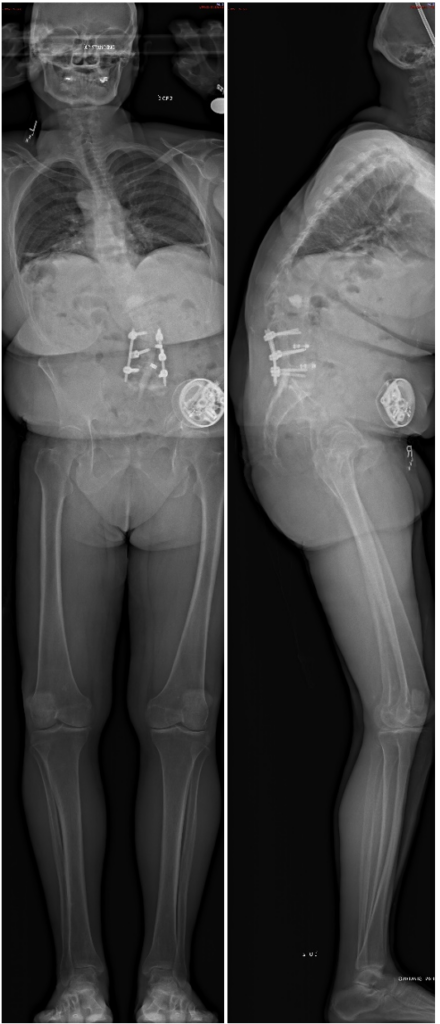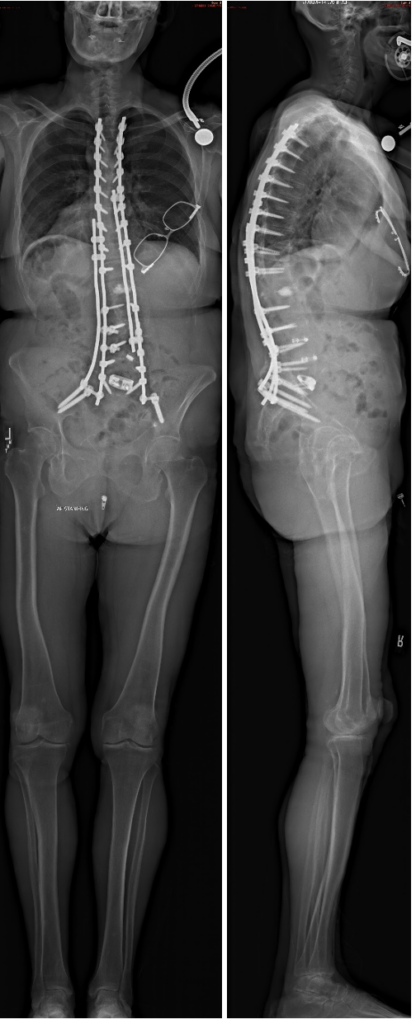

What is sagittal imbalance and what are the causes?
Sagittal imbalance is an imbalance of the spine when looking at it from the side- usually too pitched forward. The spine is supposed to have two normal front to back curves. The thoracic (middle) spine has an outward, kyphotic (forward) curve. The lumbar (lower) spine has an inward, lordotic (backward) curve.
If either of these curves becomes too pronounced or too flat, this can lead to sagittal imbalance. There are two general types of sagittal imbalance:
- Flatback syndrome: The lumbar spine loses its curve and flattens, making the thoracic spine the only curve, causing the person’s center of gravity to go too far forward.
- Kyphosis: The curve of the thoracic spine becomes greater than what it’s supposed to be (usually a curve of ~50 degrees or more), which causes the upper back to round forward and give the person a “hunchback” appearance. You can find out more information on kyphosis on this page.
Flatback syndrome and kyphosis, which result in sagittal imbalance can be caused by:
- Injury
- Congenital birth defects
- Degenerative disc disease
- Neuromuscular conditions such as cerebral palsy or MS
- Surgical fusion of the spine in a flat position
What are the symptoms?
Symptoms can vary depending on the severity, age of the patient, and type of sagittal imbalance. But the most common symptoms include:
- Low back pain
- Difficulty walking
- Disfigured appearance (Ex: hunchback due to kyphosis)
- Inability to continue standing up straight or looking straight ahead when upright
More severe cases of sagittal imbalance may put pressure on the spinal nerves, leading to weakness, numbness, or pain in the back and extremities (arms, hands, legs). There can even be pressure put on the lungs, which can cause difficulty breathing.
How is sagittal Imbalance diagnosed?
The doctor will get a brief history including the medical and family history of the patient, followed by a physical examination. Diagnostic tests such as X-rays, MRI’s, or CT scans are used to gather images of the spine and confirm the diagnosis, while also helping ruling out any other conditions.
If you suspect yourself or a loved one to be exhibiting symptoms of sagittal imbalance, don’t wait for the problem to potentially worsen. Talk to your doctor or contact us through this website to set up an appointment for an official diagnosis.
What treatment options are available?
The treatments will vary based on the patient’s specific condition and the severity of the sagittal imbalance. However, non-surgical treatments aren’t often effective, especially in more severe cases. Regardless, the goal of surgery is to regain overall sagittal imbalance. Regardless, the goal of surgery is to regain overall sagittal balance.
Osteotomy, or bone “cuts”, can help correct the spinal deformity. Osteotomy is combined with use of screws to secure the vertebrae together and keep the spine aligned. This also includes using bone graft to help facilitate the bones healing together to create long-term stability. For more information on spinal fusion surgery, please visit our page here.
If you or a loved one is suffering from sagittal imbalance, or have any questions, comments, or concerns, please contact us through the website to set up an appointment.

